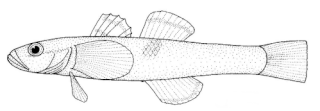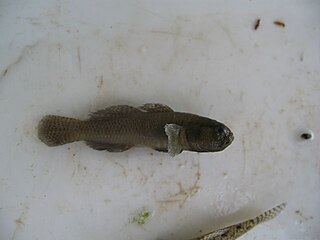Victor Gruschka Springer was an American biologist who was a Senior Scientist emeritus, Division of Fishes at the Smithsonian Institution's National Museum of Natural History in Washington, D.C. He was a specialist in the anatomy, classification, and distribution of fishes, with a special interest in tropical marine shorefishes. He published numerous scientific studies on these subjects; also, a popular book called "Sharks in Question, the Smithsonian Answer Book" 1989.

Graham's gudgeon, Grahamichthys radiata, is a species of goby of the family Thalasseleotrididae, the only member of the genus Grahamichthys. This species is found in rock pools and in the neritic zone, to 50 metres (160 ft) in depth, where sand or mud is lies around and partially buries rocks, shells, or other objects. It is unusual for a goby, in that it lives in loose schools.

Economidichthys is a genus of freshwater gobies endemic to Greece. The name of this genus honours the Greek ichthyologist Panos Economidis.
Silhouettea is a genus of gobies native to the Indian Ocean and the western Pacific Ocean. The name of this genus refers to the island of Silhouette in the Seychelles where the type specimens of the type species, Silhouettea insinuans, were collected.
Mugilogobius sarasinorum, Sarasin's goby, is a species of goby endemic to Lake Poso in Sulawesi, Indonesia. This species can reach a length of 8 centimetres (3.1 in) TL. It is important to local commercial fisheries and the fishing community.
Knipowitschia cameliae, the Danube delta dwarf goby, is a species of goby known only from the brackish and fresh waters of a lagoon south of the Danube Delta in Romania. This fish is a shallow water species being found in waters less than 1 metre (3.3 ft) deep. This species can reach a length of 3.2 centimetres (1.3 in) SL. This species has been assessed by the IUCN as Critically Endangered, possibly extinct, it was last recorded in 1994 and surveys in that year and 1998 have failed to record the species. The specific name honours Camelia Iliana Nalbant, the wife of the senior author.
Gerald Robert "Gerry" Allen is an American-born Australian ichthyologist. His career began in 1963, when he spent a semester at the University of Hawaii, where he also received a PhD in marine zoology in 1971. In 1972, Allen wrote his doctoral thesis on the systematics and biology of the anemone fish.
Akihito is a genus of gobies native to streams in Vanuatu.
Barbuligobius boehlkei, the Cryptic bearded goby, is a species of goby native to the Indian Ocean and the western Pacific Ocean where it can be found on sand-rubble substrates at depths of from 1 to 15 metres. This species grows to a length of 2 centimetres (0.79 in) SL. This species is the only known member of its genus. Its specific name honours James E. Böhlke (1930-1982) of the Academy of Natural Sciences of Philadelphia.
Echinogobius hayashii, the cheek-streaked goby, is a species of goby native to western Australia and Japan. This species can be found at depths of from 1 to 20 metres living in areas with strong tidal currents and a sandy substrate. This species grows to a length of 7 centimetres (2.8 in) SL. This species is the only known member of its genus.
Hyrcanogobius bergi, the Volga dwarf goby, is a species of goby endemic to the Caspian Sea where it occurs in fresh, brackish and marine waters along the coast. Unusual for gobies, this species is almost a fully pelagic fish. H. bergi grows to a length of 3.6 centimetres (1.4 in) SL. This species is also the only known member of its genus. The specific name honours the Soviet zoologist Lev Berg (1876-1950) who described many new species of goby from the Caspian Sea.

Kelloggella is a genus of fish in the family Gobiidae, the gobies. This genus is distributed in the Indian and Pacific Oceans. The genus name honours the American entomologist Vernon Lyman Kellogg (1867-1937) of Stanford University, the discoverer of Kelloggella cardinalis.
Larsonella pumila is a species of goby native to the Indian Ocean from the coast of Africa to the western Pacific Ocean. This species grows to a length of 1.9 centimetres (0.75 in) SL. This species is the only known member of its genus. The specific name honours the ichthyologist Helen K. Larson who was the Curator of Fishes at the Museum and Art Gallery of the Northern Territory in Darwin, for her work on the taxonomy of Indo-Pacific gobies.
Ferrer's goby is a species of goby native to the Mediterranean Sea where it occurs in inshore waters inhabiting areas with sandy substrates. This species grows to a length of 3.5 centimetres (1.4 in) TL. This species is the only known member of its genus. The specific name honours Jaume Ferrer Aledo (1854-1956), a pharmacist and amateur ichthyologist who studied the fish fauna in the Balearic Islands.
Helen K. Larson is an ichthyologist who specialises in the fishes of the Indo-Pacific.
Loren Paul Woods (1913–1979) was an American ichthyologist and museum curator at the Field Museum of Natural History In Chicago. He joined the museum's education department as a guide lecturer in 1938. In 1941, he was transferred to the Division of Fishes, from where he retired in 1978. His career was interrupted by a four-year period of duty with the United States Navy during World War II. While he was in the navy, Marion Griswold Grey served as the unpaid curator, becoming an associate at the museum when Woods resumed his post. During his time at the Field Museum, he assembled specimen collections of North American freshwater fish and Atlantic, Indian, and Pacific Ocean marine fish. This material resulted in a major expansion of the museum's fishes holdings, which had previously been a mostly freshwater collection. Woods is best remembered for his publications on damselfish, squirrelfish, and Berycidae.
Platygobiopsis akihito, the Imperial goby, is a species of goby known only from the area of Flores, Indonesia. This species reaches a length of 13 cm (5.1 in).
Gobiopsis woodsi, also known as Woods' barbelgoby, is a species of goby found in the Indo-west Pacific.
Gobiopsis namnas is a species of goby found in the north-western Pacific Ocean off Japan.
Gobiopsis liolepis is a species of goby, a type of fish.


